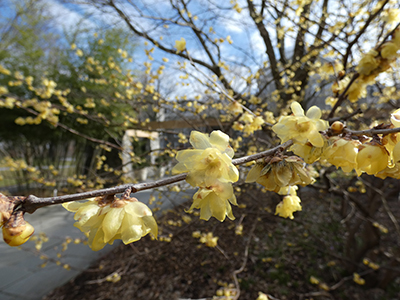
Plants of the Week: February 10

With the gray and rainy weeks blending together, it’s a great time to refresh your senses with the abundant horticultural delights of the Scott Arboretum. Even in February, there is plenty of vibrancy throughout the campus gardens to appease your eyes and nose.
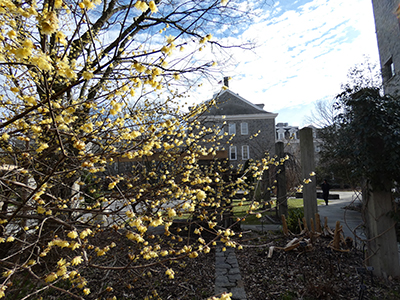
Impossible for the passerby to ignore at this time are the bright yellow blooms and strong scent of Chimonanthus praecox ‘Luteus’, the fragrant wintersweet shrub. photo credit: R. Payne-Meyer
Impossible for the passerby to ignore at this time are the bright yellow blooms and strong scent of Chimonanthus praecox ‘Luteus’, the fragrant wintersweet shrub. This member of the sweetshrub family, like it’s namesake, is known for its strongly scented flowers.
C. praecox ‘Luteus’ flowers have pendulous sulfur yellow tepals and a tantalizing, spicy scent; the ‘Luteus’ cultivar is noted for the bright coloration of the blooms and its outstanding fragrance. The lovely scent of wintersweet wafts about, and will cause those both near and far to stop in their tracks, hoping to seek the source. The vivid blooms of this shrub help to bring observers to the right place.
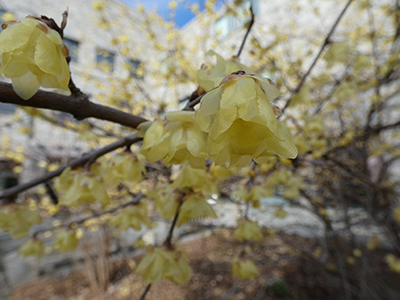
C. praecox ‘Luteus’ flowers have pendulous sulfur yellow tepals and a tantalizing, spicy scent; the ‘Luteus’ cultivar is noted for the bright coloration of the blooms and its outstanding fragrance. photo caption: R. Payne-Meyer
Leaves are opposite, long, and elliptic, turning shades of yellow in autumn. This East Asian plant is relatively low-maintenance, preferring an average well-drained soil and full sun to part-shade. C. praecox ‘Luteus’ is best utilized in a shrub border, as it has an informal form; it is also recommended to site this shrub in a well-traversed area where it will be oft-admired. You can find specimens of C. praecox ‘Luteus’ in full bloom in the Isabelle Cosby Courtyard and Winter Garden.
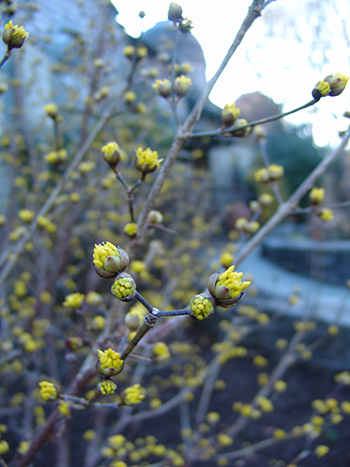
Another plant boasting yellow flowers sure to brighten any landscape is Cornus officinalis ‘Kintoki’, the Japanese cornel dogwood. photo credit: R. Robert
Another plant boasting yellow flowers sure to brighten any landscape is Cornus officinalis ‘Kintoki’, the Japanese cornel dogwood. The blooms of this dogwood appear when little else is blooming, and shine like a beacon in the winter landscape. This dogwood flowers on bare stems well before other Cornus species, providing a welcome sight when gardeners are yearning for color.
C. officinalis ‘Kintoki’ flowers a week or more before the closely related Corneliancherry dogwood (Cornus mas). Flowers are borne in tiny clusters of short-stalked umbels, enclosed by four bracts. The pedicels of Cornus officinalis ‘Kintoki’ are twice as long as the bracts of the flower, and are noted for being longer than those of Cornus mas. Prior to blooming, the swelling yellow globular buds also make for an interesting winter feature.
During the growing season, fertilized flowers ripen into small cherry red fruits that resemble coffee berries. The leaves have a tapered ovate shape and are an attractive lustrous green with pronounced arcuate venation. Like many plants of the dogwood genus, C. officinalis ‘Kintoki’ turns shades of red and purple in autumn. The bark of C. officinalis ‘Kintoki’ is also notable, exfoliating to reveal numerous tones of gray, brown, and orange.
C. officinalis ‘Kintoki’ often takes on a multi-stemmed form, and lends itself well to use as a shrub or small tree. Removal of suckers and thinning of branches creates a beautiful specimen tree, where its attractive bark and impressive winter bloom can be prominently displayed. When placed in a mixed shrub border, dense branching can be allowed to develop, making for a great shrub as well.
A tough and versatile dogwood, C. officinalis ‘Kintoki’ prefers rich, well-drained soils in full sun to part-shade, but is adaptable to a range of conditions. A specimen of C. officinalis ‘Kintoki’ is bursting into flower in Scott Entrance Garden.
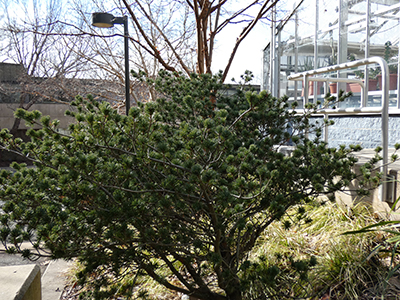
Though small in stature, Pinus parviflora ‘Adock’s Dwarf’ has an outsized effect in the garden, where its graceful form and unique needles make it a delightful accent or small specimen. photo credit: R. Payne-Meyer
Though small in stature, Pinus parviflora ‘Adock’s Dwarf’ has an outsized effect in the garden, where its graceful form and unique needles make it a delightful accent or small specimen. Dwarf conifers add tremendous value to the garden by adding year-round interest without sacrificing precious space.
This choice cultivar of Pinus parviflora, the Japanese white pine, is noted for its short, twisted blue green needles and congested, irregular shape. The candles (new growth) emerge as bright pink in the spring. The needles are white on the interior surface, and cones oval and reddish brown, offering additional ornamental value. P. parviflora ‘Adock’s Dwarf’ develops a unique, irregular flattened top over time that adds a distinct character.
A true dwarf, this plant reaches a size of 3-4 feet tall and wide at 25 years old, making it an excellent choice for restricted spaces. The small needles and limited growth make this cultivar a superb choice for bonsai as well. This dwarf conifer can grow in most well-draining soils, and prefers full sun to part-shade. Plants are drought tolerant once established.
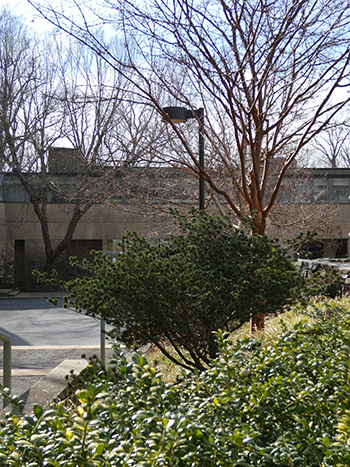
An exemplary specimen of P. parviflora ‘Adock’s Dwarf’ is located in the Winter Garden. photo credit: R. Payne-Meyer
This unique specimen conifer can find a home in anyone’s yard; consider placing P. parviflora ‘Adock’s Dwarf’ among rocks, with ornamental grasses, bulbs, groundcovers, other conifers, short perennials and smaller shrubs. An exemplary specimen of P. parviflora ‘Adock’s Dwarf’ is located in the Winter Garden.





Lynn Etheredge
Posted at 10:57h, 20 FebruaryThanks for the wonderful suggestions.!.Just what February needs! Does Scott have experience with Golden Euonymus ? A modest size evergreen (with year-round gold-green foliage, perhaps another candidate for consideration.